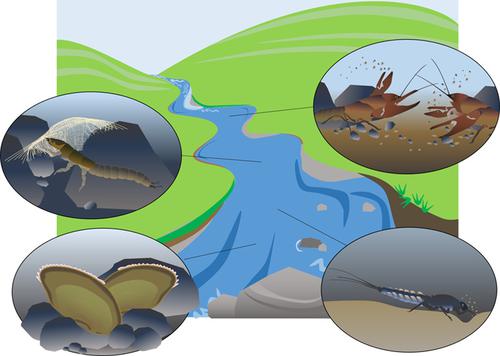当前位置:
X-MOL 学术
›
WIREs Water
›
论文详情
Our official English website, www.x-mol.net, welcomes your
feedback! (Note: you will need to create a separate account there.)
Invertebrate zoogeomorphology: A review and conceptual framework for rivers
WIREs Water ( IF 6.8 ) Pub Date : 2021-06-25 , DOI: 10.1002/wat2.1540 Richard J. Mason 1, 2 , Harry Sanders 1, 3
WIREs Water ( IF 6.8 ) Pub Date : 2021-06-25 , DOI: 10.1002/wat2.1540 Richard J. Mason 1, 2 , Harry Sanders 1, 3
Affiliation

|
Invertebrates are important sediment engineers, making up for their small body size with abundance and behavioral diversity. However, despite the recognized importance of invertebrates as sediment engineers in terrestrial and marine environments, zoogeomorphology in rivers has primarily considered larger taxa, such as fish and beaver. This article reviews the zoogeomorphic effects of invertebrates in freshwater habitats, with a focus on rivers. To better synthesize current zoogeomorphic research and to help guide future studies we build a conceptual model considering biotic (behavior, abundance, body size, life history, and species invasions) and abiotic (geophysical energy and sediment grain size) controls on the direction and magnitude of zoogeomorphology. We also incorporate invertebrate engineers into conceptual sediment entrainment models, to understand their geomorphic role in the context of hydraulic power and sediment size. We structure our review around invertebrate behavior as a key control on whether invertebrates have a sediment destabilizing or stabilizing impact. Invertebrate zoogeomorphic behavior are diverse; the majority of research concerns bioturbation, a result of locomotion, foraging, and burrowing behaviors by many taxa. Similarly, burrowing into bedrock by a caddisfly and non-biting midge larvae promotes bioerosion. Attachment to the substrate, (e.g., silk nets by caddisfly larvae or byssal threads by some mussels) can stabilize sediment, providing bioprotection. Bioconstructions (e.g., caddisfly cases and mussel shells) may have either stabilizing or destabilizing effects depending on their density and abiotic context. Interactions between lotic invertebrates and fluvial processes are complex and understudied, requiring further research across a greater range of taxa, behaviors, and spatiotemporal scales.
中文翻译:

无脊椎动物动物地貌学:河流回顾和概念框架
无脊椎动物是重要的沉积物工程师,它们以丰富的行为多样性弥补了它们的小体型。然而,尽管无脊椎动物在陆地和海洋环境中作为沉积工程师的重要性得到公认,但河流中的动物地貌学主要考虑更大的分类群,如鱼和海狸。本文回顾了淡水栖息地中无脊椎动物的动物地貌效应,重点是河流。为了更好地综合当前的动物地貌研究并帮助指导未来的研究,我们建立了一个概念模型,考虑到生物(行为、丰度、体型、生活史和物种入侵)和非生物(地球物理能量和沉积物粒度)对方向和大小的控制动物地貌学。我们还将无脊椎动物工程师纳入概念沉积物夹带模型中,了解它们在水力和沉积物大小的背景下的地貌作用。我们围绕无脊椎动物行为构建我们的评论,作为对无脊椎动物是否具有沉积物破坏稳定或稳定影响的关键控制。无脊椎动物的动物地貌行为多种多样;大多数研究关注生物扰动,是许多类群运动、觅食和挖洞行为的结果。同样,石蛾和不咬人的蠓幼虫在基岩中挖洞会促进生物侵蚀。附着在基质上(例如,石蛾幼虫的丝网或一些贻贝的丝网)可以稳定沉积物,提供生物保护。生物结构(例如,石蛾壳和贻贝壳)可能具有稳定或破坏稳定的效果,这取决于它们的密度和非生物环境。Lotic 无脊椎动物和河流过程之间的相互作用很复杂且研究不足,需要对更广泛的分类群、行为和时空尺度进行进一步研究。
更新日期:2021-08-05
中文翻译:

无脊椎动物动物地貌学:河流回顾和概念框架
无脊椎动物是重要的沉积物工程师,它们以丰富的行为多样性弥补了它们的小体型。然而,尽管无脊椎动物在陆地和海洋环境中作为沉积工程师的重要性得到公认,但河流中的动物地貌学主要考虑更大的分类群,如鱼和海狸。本文回顾了淡水栖息地中无脊椎动物的动物地貌效应,重点是河流。为了更好地综合当前的动物地貌研究并帮助指导未来的研究,我们建立了一个概念模型,考虑到生物(行为、丰度、体型、生活史和物种入侵)和非生物(地球物理能量和沉积物粒度)对方向和大小的控制动物地貌学。我们还将无脊椎动物工程师纳入概念沉积物夹带模型中,了解它们在水力和沉积物大小的背景下的地貌作用。我们围绕无脊椎动物行为构建我们的评论,作为对无脊椎动物是否具有沉积物破坏稳定或稳定影响的关键控制。无脊椎动物的动物地貌行为多种多样;大多数研究关注生物扰动,是许多类群运动、觅食和挖洞行为的结果。同样,石蛾和不咬人的蠓幼虫在基岩中挖洞会促进生物侵蚀。附着在基质上(例如,石蛾幼虫的丝网或一些贻贝的丝网)可以稳定沉积物,提供生物保护。生物结构(例如,石蛾壳和贻贝壳)可能具有稳定或破坏稳定的效果,这取决于它们的密度和非生物环境。Lotic 无脊椎动物和河流过程之间的相互作用很复杂且研究不足,需要对更广泛的分类群、行为和时空尺度进行进一步研究。











































 京公网安备 11010802027423号
京公网安备 11010802027423号